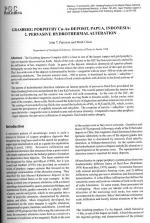Добрый день, Коллеги. Важное сообщение, просьба принять участие. Музей Ферсмана ищет помощь для реставрационных работ в помещении. Подробности по ссылке
Grasberg Porphyry Cu-Au Deposit, Papua, Indonesia: Pervasive Hydrothermal Alteration
The Grasberg Igneous Complex (GIC) is host to one of the largest copper and gold porphyry-type ore deposits discovered on Earth. Much of the rock volume in the GIC has been pervasively altered by the infiltration of hot, magmatic fluids. In parts of the deposit, alteration destroyed all igneous phases. Petrography reveals that two zones characterise almost the entire complex at the level of the open pit mine. The 1 km-wide core of the deposit is dominated by biotite + magnetite with an inner ~500 m-wide sub-zone containing andalusite. The exterior annular zone, -500 m across, is dominated by sericite + anhydrite + pyrite with small amounts of kaolinite. Pockets of rock contain epidote with chlorite in the distal portions of the GIC.
The pattern of hydrothermal alteration indicates an intense episode of pervasive fluid flow post-dated the Main Grasberg Intrusion and predated the Late Kali Intrusion. The overall pattern indicates the interior was hot and acid-producing and the exterior was cooler and acid-consuming. In the core of the GIC, the precipitation of abundant magnetite caused outwards moving fluids to become acidic. In the cooler, outer parts of the complex, these acidic fluids caused the hydrolysis of plagioclase and other minerals into sericite. The cooling of outwards flowing fluids also caused the hydrolysis of S02 to H2S and H2S04 which, in turn, caused the precipitation of sulphide minerals and anhydrite. The overprint of sericite + anhydrite + pyrite upon the biotite + magnetite zone is limited in area and of minor intensity. Compared to most other porphyry copper deposits, the pervasive infiltration of magmatic fluid ended rather abruptly.




